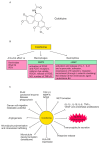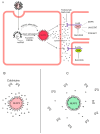Colchicine-The Divine Medicine against COVID-19
- PMID: 39064010
- PMCID: PMC11277756
- DOI: 10.3390/jpm14070756
Colchicine-The Divine Medicine against COVID-19
Abstract
Colchicine has a number of effects that suggest it may be useful in the treatment of COVID-19. Myeloid cells are a major source of dysregulated inflammation in COVID-19. The hyperactivation of the NLRP3 inflammasome and the subsequent cytokine storm take place precisely inside them and can lead to multiorgan damage and death. NLRP3 inflammasome inhibition has been assessed at micromolar colchicine concentrations which cannot be achieved in serum. However, colchicine has remarkable ability to accumulate intensively in leukocytes, where the cytokine storm is generated. Over 50 observational studies and randomized clinical trials, small randomized non-controlled trials, and retrospective cohort studies were initiated to test its healing effect in vivo, leading to conflicting, rather disappointing results. The WHO gives a "Strong recommendation against" the use of colchicine for COVID-19 treatment. This is because low doses of colchicine are always used, where the concentrations required to inhibit the NLRP3 inflammasome in leukocytes cannot be reached. Considering this, from March 2020, we started the administration of higher doses of colchicine. Our assumption was that a safe increase in colchicine doses to reach micromolar concentrations in leukocytes will result in NLRP3 inflammasome/cytokine storm inhibition. We demonstrated that in 785 inpatients treated with increasing doses of colchicine, mortality fell between two and seven times. Our data, including a large number of COVID-19 outpatients, showed that nearly 100% of the patients treated with this therapeutic regimen escaped hospitalization. In addition, post-COVID-19 symptoms in those treated with colchicine were significantly rarer. As a large number of viruses can overactivate the NLRP3 inflammasome (like seasonal influenza), we are convinced that higher colchicine doses would be useful in these cases as well.
Keywords: COVID-19; NLRP3 inflammasome; colchicine doses; colchicine toxicity; cytokine storm.
Conflict of interest statement
The author declares no conflict of interest.
Figures




References
-
- Wall W.J. The Search for Human Chromosomes: A History of Discovery. Springer; Berlin/Heidelberg, Germany: 2015. p. 88.
Publication types
Grants and funding
LinkOut - more resources
Full Text Sources
Research Materials

